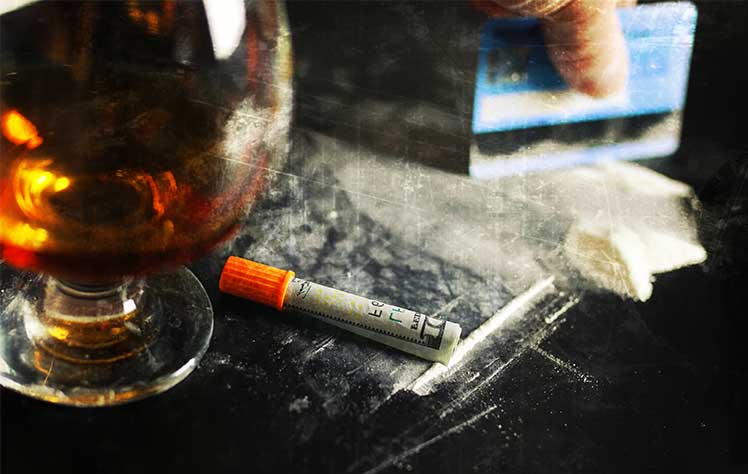List Of Dangerous Fentanyl Interactions

Medically Reviewed By: Kimberly Langdon, M.D.
Fentanyl is a potent and dangerous opioid analgesic and anesthetic prescribed to treat severe pain. The drug, in both pharmaceutical and illicit forms, can interact with a variety of substances, potentially leading to severe health effects including deadly drug overdose.

While the synthetic opioid fentanyl has earned a reputation as a dangerous illegal drug smuggled into the United States from covert overseas drug labs, it is also used in medical contexts for anesthesia or as an analgesic to control severe pain.
But because of fentanyl’s high potency and the limited number of situations in which it is appropriate to use, pharmaceutical fentanyl products such as fentanyl lozenges (Actiq), transdermal patches (Duragesic), and nasal sprays are uncommon and only prescribed with caution.
Fentanyl is also known to react with various substances, some of which can greatly increase fentanyl’s effects as well as the risk of severe or life-threatening opioid overdose.
CYP3A4 Inhibitors
Fentanyl is hepatically metabolized, meaning that it is broken down by the liver. More specifically, fentanyl is metabolized by the CYP3A4 enzyme, part of the liver’s CYP450 enzyme system.
This means that any drugs that interfere with or inhibit the CYP3A4 enzyme will also indirectly increase and prolong the amount of fentanyl present in the body, along with its effects and side-effects.
Common examples of CYP3A4 inhibitors include:
- macrolide antibiotics, including erythromycin
- azole-antifungal agents, including ketoconazole
- protease inhibitors, including ritonavir
- grapefruit juice
- protease inhibitors
CYP3A4 Inducers
Likewise, drugs that increase the effect of the CYP3A4 enzyme will tend to reduce the level of fentanyl active in the body, also reducing the drug’s effects and length of effect.
This effect can even trigger withdrawal symptoms in patients who have become dependent on fentanyl after a period of prolonged fentanyl use.
Examples of CYP3A4 inducers include:
- rifampin
- carbamazepine
- phenytoin
Benzodiazepines
Fentanyl, as with other opioid drugs, is a potent central nervous system (CNS) depressant that works by interacting with opioid receptors in the body.
Benzodiazepines, on the other hand, are also powerful CNS depressants, though they work by increasing the activity of the GABA neurotransmitter, leading to feelings of relaxation, drowsiness, and relief from anxiety and stress.
Mixing fentanyl with a benzodiazepine can greatly increase the effects of both drugs, resulting in an extremely high risk of overdose, sedation, respiratory depression, coma, and death.
Common benzodiazepines include:
- diazepam (Valium)
- alprazolam (Xanax)
- clonazepam (Klonopin)
- and others
Alcohol, Muscle Relaxants, & Other Depressants
As with benzos drugs, ethanol (drinking alcohol) acts as a strong CNS depressant.
When alcohol , muscle relaxers, or other CNS depressants are mixed with fentanyl, the risk of a complex and dangerous polydrug overdose is greatly increased.
Serotonergic Substances
Concomitant use of fentanyl with other drugs that stimulate serotonin activity can trigger symptoms of serotonin syndrome, often including restlessness, confusion, twitching, headache, shivering, goosebumps, and elevated heart rate, blood pressure, and body temperature.
This may include substances such as:
- antidepressants (SSRIs, SNRIs, TCAs)
- certain muscle relaxants (cyclobenzaprine, metaxalone)
- triptans
- mirtazapine
- trazodone
- tramadol
- MAOIs (linezolid, phenelzine, tranylcypromine)
- methylene blue
Anticholinergic Drugs
Using fentanyl with anticholinergic drugs can cause urinary retention and/or severe constipation, which may lead to a serious condition known as paralytic ileus, in which the normal motion of the bowel is stopped.
Examples of anticholinergic drugs include:
- tricyclic antidepressants, including amitriptyline
- first generation antihistamines including chlorpheniramine and diphenhydramine
- overactive bladder antimuscarinics, including oxybutynin
Illicit Drugs
In recent years, it has been increasingly common for Ohio law enforcement personnel and public health officials to find fentanyl or its analogues, like carfentanil (street name gray death), used as an active ingredient in counterfeit pills.
Fentanyl-Laced Street Drugs
Counterfeit street drugs in Ohio may include fake Oxycodone tablets and other prescription opioids as well as various other prescription drugs.
Fentanyl has also been widely found laced into various types of illicit drug supplies or sold as a fake form of heroin, to the point that harm reduction fentanyl test strips have been made widely available in the state to protect people from unintended fentanyl drug use.
Polydrug Overdoses Involving Fentanyl
As an illicit street drug, fentanyl may be taken alone or used for poly-substance use. Stimulants like methamphetamine and cocaine are common pairings for the drug, which can lead to extremely dangerous and unpredictable overdose events.
At this stage of the opioid crisis, fentanyl is the single greatest driver of overdose deaths in the United States, with fentanyl overdose/other synthetic opioid overdoses claiming the lives of over 4,000 Ohio residents in 2021 alone.
Other Fentanyl Cautions
According to prescribing information, fentanyl should not be used by patients with:
- operative interventions in the biliary tract, as this may slow the elimination of the drug in the liver
- respiratory depression or obstructive airway diseases including asthma, COPD, obstructive sleep apnea, or obesity hypoventilation
- liver failure
- intolerance towards opioid drugs
- hypersensitivity or allergies to fentanyl or any other ingredients in the medication
If you or a loved one struggle with fentanyl addiction or any other form of substance use disorder, contact Ohio Recovery Center for information on our inpatient addiction treatment options.
- Food and Drug Administration (FDA) — Actiq (fentanyl citrate) oral transmucosal lozenge https://www.accessdata.fda.gov/drugsatfda_docs/label/2011/020747s033lbl.pdf
- National Institute on Drug Abuse (NIDA) — Overdose Death Rates https://nida.nih.gov/research-topics/trends-statistics/overdose-death-rates
- National Library of Medicine: MedlinePlus — Fentanyl Transdermal Patch https://medlineplus.gov/druginfo/meds/a601202.html
- National Library of Medicine: Statpearls — Fentanyl https://www.ncbi.nlm.nih.gov/books/NBK459275/#:~:text=The%20drug%20fentanyl%20should%20not,the%20opioid%2Dinduced%20respiratory%20depression%20(

